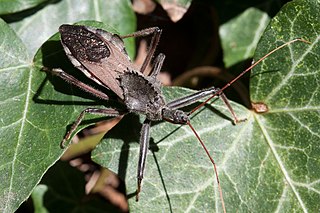
The Reduviidae is a large cosmopolitan family of the suborder Heteroptera of the order Hemiptera. Among the Hemiptera and together with the Nabidae almost all species are terrestrial ambush predators; most other predatory Hemiptera are aquatic. The main examples of non-predatory Reduviidae are some blood-sucking ectoparasites in the subfamily Triatominae, with a few species from South America noted for their ability to transmit Chagas disease. Though spectacular exceptions are known, most members of the family are fairly easily recognizable; they have a relatively narrow neck, sturdy build, and a formidable curved proboscis. Large specimens should be handled with caution, if at all, because they sometimes defend themselves with a very painful stab from the proboscis.

The members of the Triatominae, a subfamily of the Reduviidae, are also known as conenose bugs, kissing bugs, or vampire bugs. Other local names for them used in the Americas include barbeiros, vinchucas, pitos, chipos and chinches. Most of the 130 or more species of this subfamily feed on vertebrate blood; a very small portion of species feed on invertebrates. They are mainly found and widespread in the Americas, with a few species present in Asia and Africa. These bugs usually share shelter with nesting vertebrates, from which they suck blood. In areas where Chagas disease occurs, all triatomine species are potential vectors of the Chagas disease parasite Trypanosoma cruzi, but only those species that are well adapted to living with humans are considered important vectors. Also, proteins released from their bites have been known to induce anaphylaxis in sensitive and sensitized individuals.

Rhodnius is a genus of assassin bugs in the subfamily Triatominae, and is an important vector in the spread of Chagas disease. The Rhodnius species were important models for Sir Vincent Wigglesworth's studies of insect physiology, specifically growth and development.

The Emesinae, or thread-legged bugs, are a subfamily of the Reduviidae. They are conspicuously different from the other reduviids by their very slender body form. They are stalking, predatory insects that can be collected on palm fronds, cliffs, spider webbing, or near lights at night. They walk on their mid and hind legs; the front pair is raptorial. Some groups specialize on spiders. Very little is known about emesines except that many species are found in the tropics. Pedro Wygodzinsky wrote the most recent revision of this group.

Arilus, or wheel bugs due to the semicircular crest on the pronotum, is a genus of true bugs in the family Reduviidae, subfamily Harpactorinae and tribe Harpactorini. Most species are found in the Americas. Arilus is a generalist predator of insects.
Ghilianella is a genus of true bug in the subfamily Emesinae. Fifty-eight species have been described, with a distribution from Guatemala to Brazil. The linear form of the species in this genus allow the young larvae to be carried about by the mother or perhaps the father. The larvae of the young can curl around the parent's thorax.
Ghilianella phasma is a species of assassin bug in the subfamily Emesinae. It is found on the Indian subcontinent and in Myanmar. There is some debate about whether this species may belong in the genus Schidium. William Lucas Distant placed the species in Ghilianella but Ernst Evald Bergroth and Pedro Wygodzinsky moved it to Schidium. In his 1990 work of the Reduviidae of the world, Moldonado doubted the Schidium placement.

The Harpactorinae are a large subfamily of the Reduviidae. About 300 genera and 2,000 species worldwide have been described. Some of the species of the genera Zelus, Pselliopus, Sinea, and Apiomerus are of interest as biological pest control agents.

Emesopsis is a genus of tropical bugs (Heteroptera) from the family Reduviidae. There are at least 22 described species, of which one, E. nubila, also occurs in southern Europe.

Brontostoma is a neotropical genus of assassin bugs in the family Reduviidae. About 20 species have been described. These species are brightly colored with reds and oranges, and like all members of the Ectrichodiinae, specialize on millipede prey.
Phasmatocoris spectrum is a thread-legged bug species from the genus Phasmatocoris. It is found in South America, having been recorded in Brazil, Colombia, Bolivia, and Venezuela. The Colombia record was taken from a “Palma Real” tree in the forest interior. Phasmatocoris papei sp. nov. is described from French Guiana based on two male specimens. Short taxonomical notes on Phasmatocoris praecellens and Ph. spectrum Breddin, 1904 are provided. An updated key to the species of Phasmatocoris Breddin, 1904 is presented.
The Centrocnemidinae are a subfamily of the reduviid, found exclusively on tree trunks, where their bodies camouflage well. There are four genera with about 34 species described.
Agriocleptus is a small genus of assassin bugs.
Amauroclopius is a small genus of assassin bugs belonging to the family Reduviidae.

The Reduviinae are a subfamily of the reduviid assassin bugs. Many members of the subfamily are nocturnal and their lifecycles are generally poorly known. This subfamily is suspected not to be monophyletic.
Gardena insperata is a thread-legged bug species from the genus Gardena. It is found in Tajikistan and Afghanistan.
Rhynocoris tristis is a species of assassin bug family (Reduviidae), in the subfamily Harpactorinae. R. tristis is a polyphagous predator found in sub-Saharan Africa.
Austrokatanga monteithi is a species of assassin bug, the sole member of its genus, in the subfamily Ectrichodiinae of Reduviidae. This species is found in Australia.

Ptilocnemus femoralis is a species of feather-legged bugs in the subfamily Holoptilinae. This species is found in Australia and has a specialized gland called a trichome that produces a chemical to attract and paralyze ants.
Rhynocoris marginatus is a species of assassin bug in the family Reduviidae. It is a predator of other insects and is found in Asia. Crops in India on which it has been found feeding on pests include sugarcane, pigeon pea, cardamom, cotton, tea, and peanuts. The insects are potentially useful in biological control because they are more resistant to pesticides than are the pests on which they feed.








